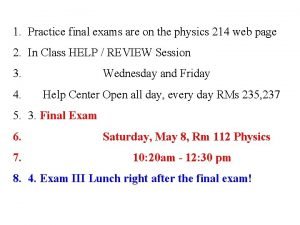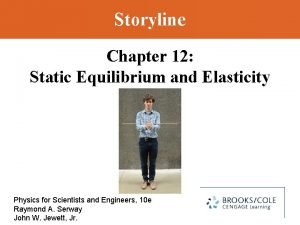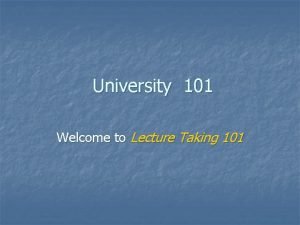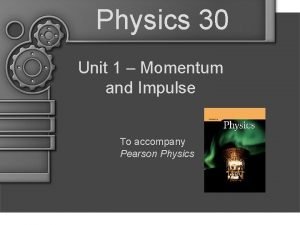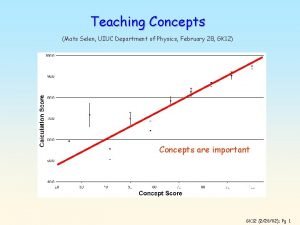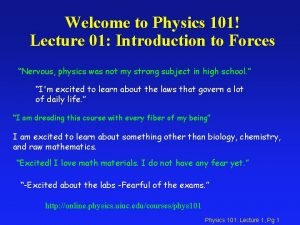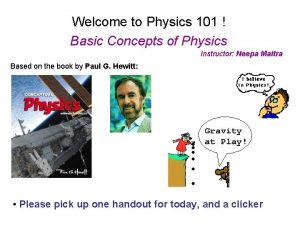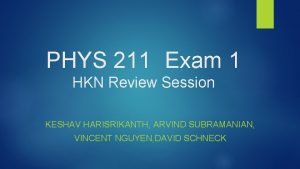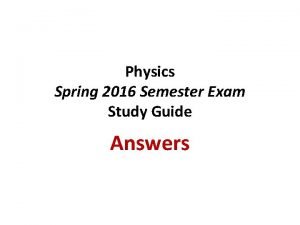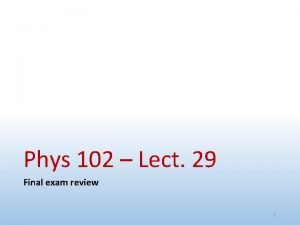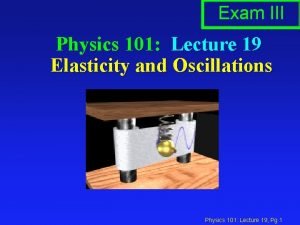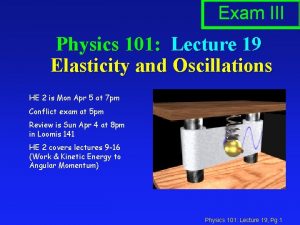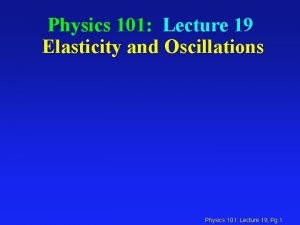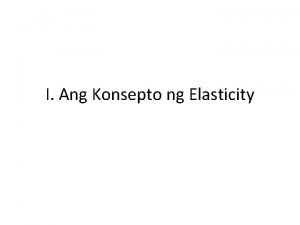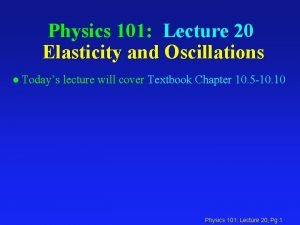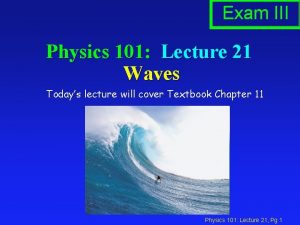Exam III Physics 101 Lecture 20 Elasticity and







![Simple Harmonic Motion: Quick Review x(t) = [A]cos( t) v(t) = -[A ]sin( t) Simple Harmonic Motion: Quick Review x(t) = [A]cos( t) v(t) = -[A ]sin( t)](https://slidetodoc.com/presentation_image_h2/5b0f2138af1f6c7de1a47a2ff9f95bb9/image-8.jpg)













- Slides: 21

Exam III Physics 101: Lecture 20 Elasticity and Oscillations l Today’s lecture will cover Textbook Chapter 10. 5 -10. 10 Physics 101: Lecture 20, Pg 1

Review Energy in SHM l A mass is attached to a spring and set to motion. The maximum displacement is x=A èEnergy = U + K = constant! = ½ k x 2 + ½ m v 2 èAt maximum displacement x=A, v = 0 Energy = ½ k A 2 + 0 èAt zero displacement x = 0 Energy = 0 + ½ mvm 2 ½ k A 2 = ½ m v m 2 vm = sqrt(k/m) A èAnalogy with gravity/ball PES x 0 m x=0 Physics 101: Lecture 20, Pg 2 05 x

Kinetic Energy ACT In Case 1 a mass on a spring oscillates back and forth. In Case 2, the mass is doubled but the spring and the amplitude of the oscillation is the same as in Case 1. In which case is the maximum kinetic energy of the mass the biggest? A. Case 1 B. Case 2 C. Same Physics 101: Lecture 20, Pg 3 09

Potential Energy ACT In Case 1 a mass on a spring oscillates back and forth. In Case 2, the mass is doubled but the spring and the amplitude of the oscillation is the same as in Case 1. In which case is the maximum potential energy of the mass and spring the biggest? A. Case 1 B. Case 2 C. Same Look at time of maximum displacement x = A Energy = ½ k A 2 + 0 Same for both! Physics 101: Lecture 20, Pg 4 12

Kinetic Energy ACT PE = 1/2 kx 2 KE = 0 x=-A x=0 x=+A PE = 0 KE = KEMAX same for both x=-A x=0 x=+A A) Case 1 B) Case 2 C) Same Physics 101: Lecture 20, Pg 5 14

Velocity ACT In Case 1 a mass on a spring oscillates back and forth. In Case 2, the mass is doubled but the spring and the amplitude of the oscillation is the same as in Case 1. Which case has the largest maximum velocity? 1. Case 1 2. Case 2 3. Same maximum Kinetic Energy K = ½ m v 2 smaller mass requires larger v Physics 101: Lecture 20, Pg 6 16

Review: Simple Harmonic Motion Period = T (seconds per cycle) Frequency = f = 1/T (cycles per second) Angular frequency = = 2 f = 2 /T Physics 101: Lecture 20, Pg 7 17
![Simple Harmonic Motion Quick Review xt Acos t vt A sin t Simple Harmonic Motion: Quick Review x(t) = [A]cos( t) v(t) = -[A ]sin( t)](https://slidetodoc.com/presentation_image_h2/5b0f2138af1f6c7de1a47a2ff9f95bb9/image-8.jpg)
Simple Harmonic Motion: Quick Review x(t) = [A]cos( t) v(t) = -[A ]sin( t) a(t) = -[A 2]cos( t) x(t) = [A]sin( t) OR v(t) = [A ]cos( t) a(t) = -[A 2]sin( t) xmax = A Period = T (seconds per cycle) vmax = A Frequency = f = 1/T (cycles per second) amax = A 2 Angular frequency = = 2 f = 2 /T Physics 101: Lecture 20, Pg 8 19

Period T of a Spring l Simple Harmonic Oscillator è = 2 f = 2 / T èx(t) = [A] cos( t) èv(t) = -[A ] sin( t) èa(t) = -[A 2] cos( t) Demos: l Draw FBD write F=ma A, m, k dependence kx=ma -k A = m amax -k A = m (-A 2) A 2 = (k/m) A = sqrt(k/m) Physics 101: Lecture 20, Pg 9 23

Period ACT If the amplitude of the oscillation (same block and same spring) is doubled, how would the period of the oscillation change? (The period is the time it takes to make one complete oscillation) A. The period of the oscillation would double. B. The period of the oscillation would be halved C. The period of the oscillation would stay the same CORRECT x +2 A t -2 A Physics 101: Lecture 20, Pg 10 27

Vertical Mass and Spring l If we include gravity, there are two forces acting on mass. With mass, new equilibrium position has spring stretched d èSFy = 0 kd – mg = 0 d = mg/k Let this point be y=0 èSF = ma k(d-y) – mg = ma -k y = ma èSame as horizontal! SHO èNew equilibrium position y=-d Physics 101: Lecture 20, Pg 11 31

Vertical Spring ACT If the springs were vertical, and stretched the same distance d from their equilibrium position and then released, which would have the largest maximum kinetic energy? 1) M 2) 2 M 3) Same PE = 1/2 k y 2 Y=0 PE = 1/2 k y 2 Just before being released, v=0 y=d Etot = 0 + ½ k d 2 Same total energy for both When pass through equilibrium all of this energy will be kinetic energy again same for both! Y=0 Physics 101: Lecture 20, Pg 12 33

Pendulum Motion l For small angles èT = mg èTx = -mg (x/L) Note: F proportional to x! èS Fx = m ax -mg (x/L) = m ax ax = -(g/L) x èRecall for SHO a = - 2 x L T = sqrt(g/L) T = 2 sqrt(L/g) Period does not depend on A, or m! x m mg Physics 101: Lecture 20, Pg 13 37

Preflight 1 Suppose a grandfather clock (a simple pendulum) runs slow. In order to make it run on time you should: CORRECT 1. Make the pendulum shorter 2. Make the pendulum longer Physics 101: Lecture 20, Pg 14 38

Elevator ACT A pendulum is hanging vertically from the ceiling of an elevator. Initially the elevator is at rest and the period of the pendulum is T. Now the pendulum accelerates upward. The period of the pendulum will now be A. greater than T B. equal to T C. less than T Physics 101: Lecture 20, Pg 15 42

ACT A pendulum is hanging vertically from the ceiling of an elevator. Initially the elevator is at rest and the period of the pendulum is T. Now the pendulum accelerates upward. The period of the pendulum will now be. If you are accelerating upward your weight is the same as if g had 1. increased 2. same 3. decreased “Effective g” is larger when accelerating upward (you feel heavier) Physics 101: Lecture 20, Pg 16 44

Elevator ACT A pendulum is hanging vertically from the ceiling of an elevator. Initially the elevator is at rest and the period of the pendulum is T. Now the pendulum accelerates upward. The period of the pendulum will now be 1. greater than T 2. equal to T CORRECT 3. less than T “Effective g” is larger when accelerating upward (you feel heavier) Physics 101: Lecture 20, Pg 17 44

Alien Preflight Knowing the difference between earth and the moon isn't going to save you from the probing these space invaders are clearly after… It's hard for me to imagine such preposterous scenarios throw the wristwatch up in the air, if it seems to stay in the for a long period of time (i. e. less gravity) you are on the moon. you could make a simple pendulum with your shoe and shoe lace and then calculate how long the period of that pendulum should be on earth the moon is made of cheese so not as much gravity. PS this is probably thee most random question you could've asked. . . Physics 101: Lecture 20, Pg 18 46

Preflight Imagine you have been kidnapped by space invaders and are being held prisoner in a room with no windows. All you have is a cheap digital wristwatch and a pair of shoes (including shoelaces of known length). Explain how you might figure out whether this room is on the earth or on the moon find the period by timing the movement of your shoes, then use the formula T=2 pi*sqrt(L/g) to find the acceleration due to gravity. then you'll know whether you're on the moon or just chillin with aliens on earth. Physics 101: Lecture 20, Pg 19 50

Summary l Simple Harmonic Motion èOccurs when have linear restoring force F= -kx èx(t) = [A] cos( t) èv(t) = -[A ] sin( t) èa(t) = -[A 2] cos( t) l Springs èF = -kx èU = ½ k x 2 è = sqrt(k/m) l Pendulum (Small oscillations) è = sqrt(L/g) Physics 101: Lecture 20, Pg 20 50

Practice Problems Chapter 10, problems 29, 33, 35, 37, 39, 41, 43, 45 (good problem!), 49, 51, 53, 57, 61, 65, 77, 89, 97 Physics 101: Lecture 20, Pg 21
 What is a harmonic wave in physics
What is a harmonic wave in physics Physics 101 lecture 1
Physics 101 lecture 1 Physics 101 lecture notes pdf
Physics 101 lecture notes pdf Waves pdf notes
Waves pdf notes Physics 101 final exam
Physics 101 final exam A solid brass sphere is initially surrounded by air
A solid brass sphere is initially surrounded by air Hamlet act iii scene ii
Hamlet act iii scene ii 01:640:244 lecture notes - lecture 15: plat, idah, farad
01:640:244 lecture notes - lecture 15: plat, idah, farad Lecture 101
Lecture 101 Physics 111 lecture notes
Physics 111 lecture notes Atmospheric physics lecture notes
Atmospheric physics lecture notes Physics 30 worksheet # 1 momentum
Physics 30 worksheet # 1 momentum Wipo worldwide academy
Wipo worldwide academy Psych 101 exam 4
Psych 101 exam 4 Mats selen uiuc
Mats selen uiuc Uiuc physics 101
Uiuc physics 101 Uiuc phys 101
Uiuc phys 101 Basic physics 101
Basic physics 101 Physics 211 exam 1
Physics 211 exam 1 Physics semester 1 final exam study guide answers
Physics semester 1 final exam study guide answers Physics 20 final exam practice
Physics 20 final exam practice Physics 102 final exam
Physics 102 final exam




